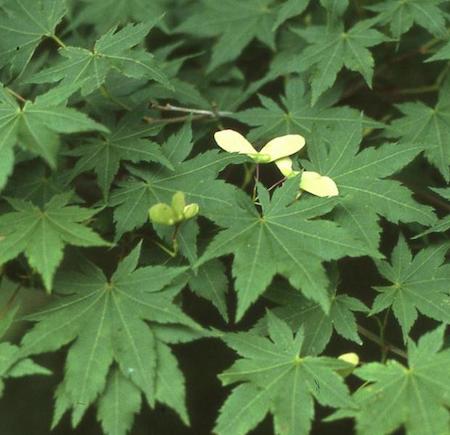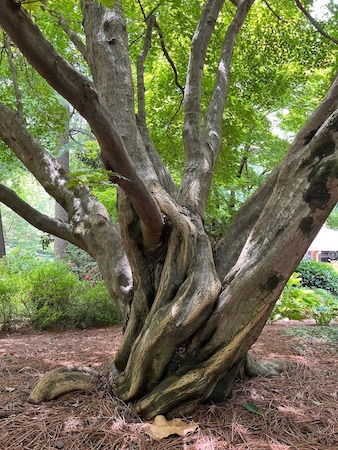Japanese Maple
Specifications
- Latin (scientific) name: Acer palmatum
- Life expectancy: 100 years
- Height: 23 feet
- Circumference: 27 inches
-
The height and circumference measurements listed above are for the largest-known Japanese maple in the City of Atlanta, located at the Callanwolde Arts Center. This species can grow to 50 feet in the wild.
-
Special characteristics:
This tree is highly prized as an ornamental. It deserves a prominent place in your yard, or it can be displayed as a bonsai tree in a small pot.
Two outstanding qualities make the Japanese maple tree a real show stopper. First, its leaves are delicate and finely textured. Second, it comes in many varieties.
The Japanese maple has been designed through cross-breeding to grow in many ways. There are different leaf shapes: some lacy, others finely toothed, and on and on. Leaf colors range from green to blood red to variegated (bi-colored) and beyond. You can even get a Japanese maple that changes colors in the Spring and the Fall. That’s why when you go to a nursery to choose one, you’ll see the Latin name Acer palmatum with the extension “var.” which, with another word, identifies that particular variety.
If you are patient enough to wait for this tree to reveal its true self, you’ll find that the Japanese maple is poetic in form. It will grow a branch structure you just have to stop to admire from time to time. The branches are layered horizontally, giving it a three-dimensional look. Sometimes it has a single trunk; but often it grows multiple trunks. The bark is smooth, muscular looking, and invites touch. Take a minute to run your hand up and down one of the limbs. Caress the leaves with the palm of your hand and then take a pass with the back of your hand. Afterwards, take a few deep breaths and you’ll chase off a lot of stress. Delightful!
Tree #2 was planted in Atlanta by Patty Jenkins. It was given to her by her father in 1999.
-
Annoyance factors:
Japanese maples grow slowly, and so take many years to reach their full size. If you’ve lusted over someone else’s radiant Japanese maple, you will have to wait a long time or settle with the reality that it’s going to be your children who will see the finished form.
Japanese maples do not transplant very well. They usually die when you dig them up. Think of the area they will inhabit in their full-sized form before you plant so you or its future owners don’t have to resort to drastic pruning when it outgrows its space.
This tree needs careful monitoring. There are a number of insects and diseases that can make your perfect tree not look so perfect. Your tree inspector can tell you what to look for.
-
Fun Facts:
Some of the names that are given to varieties of Japanese maple are quite wonderful. There are “Crimson Queen,” “Waterfall,” and “Inaba Shindare,” to name a few. The names are so descriptive, and certainly easier to remember than the Latin names! Go to the internet and check them out. There is even an organization or two centered around the propagation and ownership of Japanese maples.
-
Photo Credits:
Green leaves: T. Davis Sydnor, Ohio State University, Bugwood.org
Purple leaf: Chris Evans, University of Illinois, Bugwood.org
Orange leaves, Seeds, Tree: T. Davis Sydnor, Ohio State University, Bugwood.orgFor images of many different varieties of Japanese maples, see Dave's Garden blog.








